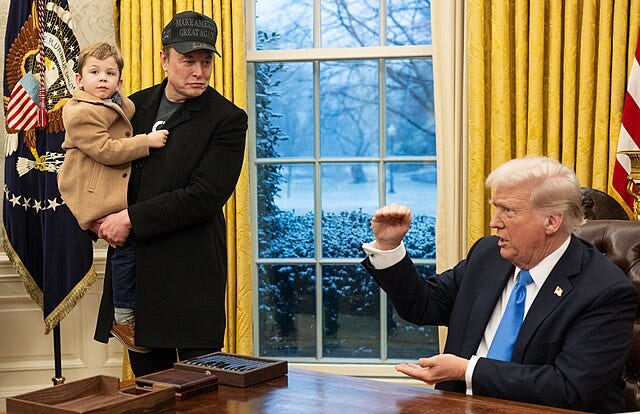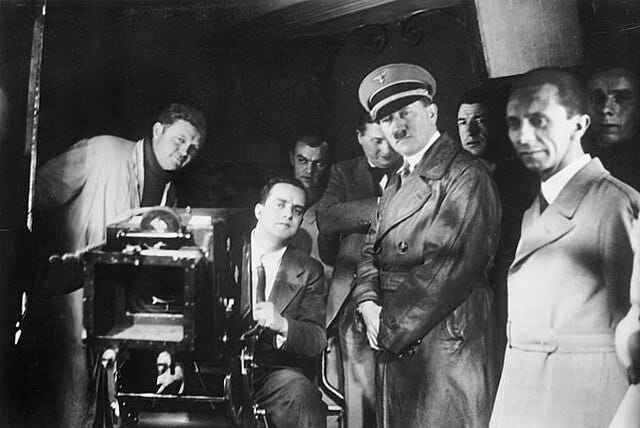My Struggle with Project 2025
Adolf Hitler’s Mein Kampf and America’s Project 2025 share unsettling themes of power centralization, cultural conformity, and national revival through exclusion.
A century ago, a young and disillusioned Adolf Hitler sat in a Bavarian jail, the consequence of his failed coup against the Weimar Republic. During his time in confinement, he wrote Mein Kampf (“My Struggle”), a manifesto that laid the foundation for his political ascent and the ideological blueprint for Nazi Germany. He argued that Germany could reclaim its greatness through a combination of strong leadership, territorial expansion, and the purging of internal enemies who, he claimed, weakened the nation’s racial and cultural integrity.
In 2024, nearly one hundred years later, a coalition of American conservative think tanks and political operatives led by the Heritage Foundation published Project 2025, a policy framework for a second Trump administration. The document proposes restoring American strength through aggressive immigration enforcement, restructuring the federal government, and reasserting traditional cultural norms.
The Project 2025 agenda includes disrupting what it calls the “administrative state,” empowering the president to exert greater control over the executive branch, and using federal power to suppress progressive cultural influence. Alongside this platform, former President Donald Trump floated the idea that the United States should annex Canada and Greenland to secure additional land and resources for national security and economic growth.
While Mein Kampf and Project 2025 are products of vastly different eras, and vary in language, intent, and extremity, the thematic parallels invite scrutiny. Both emerge from periods of national disillusionment. Both position the state as besieged from within. And both present strong, centralized leadership as the remedy to perceived national decline.
Historical Backdrop
Mein Kampf was written in the aftermath of World War I, a conflict Germany initiated and lost. Although the German army was never defeated on the battlefield, the population at home faced famine, economic collapse, and political upheaval. The Treaty of Versailles imposed harsh reparations, igniting nationalist resentment and economic despair. Hitler – a World War I combat veteran – interpreted Germany’s defeat as a betrayal by bureaucrats and democratic politicians. His answer was to tear down the existing government and impose a new order founded on racial purity and authoritarian control.
The modern United States is not suffering from war or occupation, but many Americans feel alienated by rapid cultural and economic change. Deindustrialization hollowed out the middle class in the nation’s interior. Factory closures and offshoring have created resentment, especially among rural and working-class communities. Some see immigration, globalization, and liberal cultural shifts as threats to traditional identity and economic security. Project 2025 responds to this perceived erosion, offering a roadmap to reverse progressive gains and restore a nationalistic vision of American strength.
Both documents arise from moments of national anxiety. In Hitler’s Germany, it was the humiliation of military defeat and political chaos. In Trump’s America, it is the fear that national identity is slipping away – culturally, economically, and demographically.
Centralization of Executive Power
In Mein Kampf, Hitler calls for the total rejection of democratic governance. He outlines a system in which the Führer – a single, unchallenged leader – embodies the will of the people. This concept, known as Führerprinzip, discards institutional checks and balances in favor of absolute authority.
Project 2025 does not call for dismantling democracy, but it does advocate for dramatic changes to the structure of executive power. A key proposal is the reinstatement of Schedule F. This Trump-era executive order would allow the president to reclassify tens of thousands of federal employees, effectively converting the civil service into a political instrument of the White House. The aim is to eliminate bureaucratic resistance to presidential directives and assert the unitary executive theory – that the president has sole authority over the executive branch.
Both frameworks argue that democratic institutions and bureaucratic independence obstruct decisive leadership. Each favors a streamlined, obedient state apparatus centered around an empowered executive.
Purging the Bureaucracy
Hitler saw the Weimar bureaucracy as bloated, incompetent, and loyal to a failed democratic system. In Mein Kampf, he calls for its removal and replacement with a new administrative order aligned with Nazi ideology.
Project 2025 takes a parallel stance. It frames the federal workforce as dominated by liberal, career officials who act as a “deep state” undermining conservative leadership. The solution is to remove these officials and replace them with politically aligned personnel. Schedule F and other proposals would make tens of thousands of positions at-will appointments, drastically reducing the insulation of civil servants from political interference.

Both approaches view the administrative state as an ideological battleground. And both call for a purge of institutional actors seen as disloyal to the national project.
Cultural Conformity
In Mein Kampf, Hitler identifies Jews, communists, and liberals as corrupting influences within German society. He promotes a racialized nationalism that fuses ethnic purity with ideological orthodoxy.
Project 2025 promotes a form of cultural homogeneity rooted in Christian conservatism. While it avoids racial language, it targets progressive ideals as threats to American culture, particularly those related to LGBTQ+ rights, diversity and inclusion efforts, and secular or left-leaning educational content. It calls for the rollback of “woke” ideologies in schools, media, and government institutions.
Both documents advocate the imposition of a singular cultural identity and treat pluralism as a weakness. Mein Kampf seeks racial purity, while Project 2025 seeks ideological and cultural conformity under a religiously influenced national identity.
Nationalism and Sovereignty
Hitler’s foreign policy vision in Mein Kampf centered on Lebensraum – the conquest of Eastern Europe to provide Germany with the land and resources necessary for its survival and dominance. Expansion was framed as a moral and biological imperative.
Project 2025 does not pursue geographic conquest but does promote a hardened nationalism focused on border enforcement and economic protectionism. The document supports mass deportations, tighter immigration controls, and a retreat from global trade agreements and multilateral commitments. In this view, sovereignty is compromised by international institutions, treaties, and foreign influence.
Both frameworks use nationalism as a vehicle for renewal. Each casts outsiders – defined by race, ideology, or origin – as threats to internal unity and national strength.
Rejection of Globalism
Mein Kampf presents internationalism as a threat to German sovereignty, part of a Jewish conspiracy to weaken the nation through foreign entanglements and racial dilution.
Project 2025 rejects internationalism through a more modern and ideological lens. It calls for the United States to withdraw from global climate accords, reduce funding to international organizations, and pursue a unilateral foreign policy based on American interests. Multilateralism is portrayed as incompatible with national self-determination.
Though their motivations differ – Hitler’s grounded in racial conspiracy, Project 2025 in nationalist ideology – both share a deep skepticism of international cooperation and seek to disentangle their nations from global influence.
Narrative Control and Messaging
Hitler considered propaganda essential to governance. In Mein Kampf, he wrote that effective propaganda must be emotional, simple, and repetitive. It was not about informing the public but shaping behavior and enforcing loyalty.

Project 2025 proposes an institutional version of this idea. It seeks to reshape public education, eliminate federal funding for liberal academic programs, and support conservative media channels. These efforts are positioned as a corrective to what is portrayed as decades of progressive cultural dominance.
Where Hitler openly endorsed propaganda as a tool of manipulation, Project 2025 casts its efforts as reform. But in both cases, control of public discourse is seen as vital to shaping national identity and ensuring political continuity.
Framing Political Conflict
Mein Kampf portrays history as a violent and necessary struggle between competing races and ideologies. National greatness, according to Hitler, is born through conquest and domination.
Project 2025 uses the language of struggle in a political and cultural context. It describes its mission as a battle against the forces of moral decay and institutional corruption. Progressive educators, federal bureaucrats, and media elites are cast as enemies in a war to save the nation’s soul.
In both documents, opposition is not considered a legitimate political difference but a dangerous threat to national survival. Each uses conflict – violent or ideological – as a rationale for transformation.
The Danger in the Rhyme
As Mark Twain famously observed, history doesn’t repeat itself but often rhymes. The comparison between Mein Kampf and Project 2025 is not moral equivalence. Hitler’s program led to genocide and World War II. Project 2025 operates within the bounds of a constitutional democracy.
But parallels exist. Both documents emerge from periods of discontent. Both respond with calls for centralized authority, national purification, and suppression of dissent. Both frame internal reform as a battle for survival. And both exploit fear – of outsiders, change, and decline – to justify radical state restructuring.
The lesson is not that history is repeating, but that it is echoing. Recognizing those echoes is essential to safeguarding democratic institutions and resisting political movements that seek to narrow the definition of belonging and place power above principle.






